Description
The simpleRTK3B Heading is a standalone board designed to evaluate dual-band RTK GNSS technology, offering centimeter-level accurate positioning, sub-degree heading, microSD datalogging, and optional native Ethernet functionality. Based on the Septentrio mosaic-H module, similar to simpleRTK3B heading from Ardusimple, it can function independently or connect with various platforms such as Arduino, Ardupilot/Pixhawk (JST connector), Raspberry Pi, Nvidia Jetson, and STM32 Nucleo, providing up to 20 RTK positions and attitude (heading) updates per second. This board is ideal for advanced projects utilizing the Pixhawk autopilot.
Additional Information:
- Requires two compatible multiband GNSS antennas (not included).
- Embedded Ethernet functionality is included (special Ethernet adapter not included; see related product).
- Standard GNSS antennas will not provide optimal performance; an L1/L2/E5b antenna is required.
- Includes an onboard XBee socket for expanding functionality with plugins such as MR/LR/XLR radios, Bluetooth, WiFi, dataloggers, RS232, Canbus, L-Band, and 4G/3G/2G.
- Comes with a built-in microSD datalogger (microSD card not included).
- A second plugin socket is available with the Shield for the simultaneous connection of two plugins.
- Preconfigured as a Rover but can also function as a Base Station.
- Recommended for testing Septentrio Mosaic-H performance.
MOSAIC-H module features:
- 31.0 x 31.0 x 4.2 mm LGA package
- Supports all-constellation multi-frequency on-chip RTK positioning and dual-antenna heading solution
- Supports GPS L1/L2, BDS B1I/B2I/B3I, GLONASS G1/G2, Galileo E1/E5b and QZSS L1/L2
- All-system multi-frequency RTK engine and advanced RTK technology
- AIM+: Industry leading Anti-jamming, Anti-spoofing Interference Monitoring and Mitigation
- IONO+: Advanced protection against ionospheric disturbances to GNSS signals
- APME+: a posteriori multipath estimator for code and phase multipath mitigation
- LOCK+: superior tracking robustness under heavy mechanical shocks or vibration
- RAIM+: Advanced Receiver Autonomous Integrity Monitoring
Performance Specifications:
Frequency
- GPS L1C/A/L2P (Y)/L2C
- BDS B1I/B2I/B3I
- GLONASS G1/G2
- Galileo E1/E5b
- QZSS L1C/A, L1C/B, L2C
Single point positioning (RMS):
- Horizontal: 1.2 m
- Vertical: 1.9 m
- Time Precision(xPPS out) – 5 ns
- Data Update Rate: 100 Hz
DGPS (RMS):
- Horizontal: 0.4 m
- Vertical: 0.7 m
- Cold start < 45 s
- Initialization Time < 1 s (typical)
- Data Update Rate: 50 Hz
RTK (RMS):
- Horizontal: 0.6 cm + 0.5 ppm
- Vertical: 1cm + 1 ppm
- Data Update Rate: 20 Hz
- Differential Data – RTCM V2.x, V3.X (MSM included), CMR v2.0/CMR+ (input only)
- Data Format – NMEA-0183, v2.3, v3.03, v4.0, RINEX v2.x, v3.x, Septentrio Binary Format (SBF)
Physical Characteristics:
- Packaging: 239 pin LGA
- Dimension: 31.0 × 31.0 × 4.2 mm
- Weight: 6.8g
Environmental Specifications:
- Working temperature: -40 °C ~ +85 °C
- Storage temperature: -55 °C ~ +85°C
- Humidity: 95% No condensation
- Vibration: MIL-STD-810G
Communication Interfaces:
- 4 × UART (3 with hardware flow control)
- 1 × USB (2.0, HS)
- 1 × Ethernet (RMII/MDIO), 10/100 Mbps
- 1 x SD memory card
- 2 x Event inputs
- 2 x GPIO
- 1 x PPS out
Agriculture: Precision farming depends on precise positioning to improve crop yields and diminish asset utilization. The SimpleRTK3A Heading ensures that machinery operates with exact positioning, leading to efficient field management.
Surveying: For land surveyors, accuracy is paramount. The SimpleRTK3A Heading provides the precision needed to create detailed and reliable maps and models.
Autonomous Vehicles: The future of transportation relies on solid navigation systems. The SimpleRTK3A Heading offers the precision required for the safe and efficient operation of autonomous vehicles.
What is the SimpleRTK3A Heading?
The simpleRTK3A Heading is a standalone board designed to evaluate dual-band RTK GNSS technology. It provides centimeter-level accurate positioning, sub-degree heading, and microSD data logging capabilities. It also features optional native Ethernet functionality.
What technology is the simpleRTK3A Heading based on?
It is based on the Septentrio mosaic-H module, which offers advanced GNSS capabilities.
Can the simpleRTK3A Heading be used with other platforms?
Yes, it can be connected to Arduino, Ardupilot/Pixhawk (JST connector), Raspberry Pi, Nvidia Jetson, and STM32 Nucleo platforms, providing up to 20 RTK positions and attitude (heading) updates per second.
What kind of projects is the simpleRTK3A Heading ideal for?
It is ideal for advanced projects using the Pixhawk autopilot and other applications requiring precise GNSS positioning and heading information.
Does the simpleRTK3A Heading come with GNSS antennas?
No, the product is compatible with multiband GNSS antennas, but these are not included. Two antennas are necessary to use the product effectively.
What type of GNSS antenna is required for optimal performance?
A: The simpleRTK3A Heading requires an L1/L2/E5b antenna for optimal performance. Standard GNSS antennas will not provide good results.
How is the simpleRTK3A Heading configured out of the box?
It is preconfigured as a Rover but can also be used as a Base Station.
Is there support for additional functionalities?
Yes, the onboard XBee socket allows for expansion with various plugin accessories, including MR/LR/XLR radios, Bluetooth, WiFi, data loggers, RS232, Canbus, L-Band, and 4G/3G/2G. Additionally, the Shield for Second Plugin socket enables connection of two plugins simultaneously.
Is Ethernet functionality available on the SimpleRTK3A Heading?
Yes, it has embedded Ethernet functionality. However, a special Ethernet adapter is required, which is not included (see related product).








